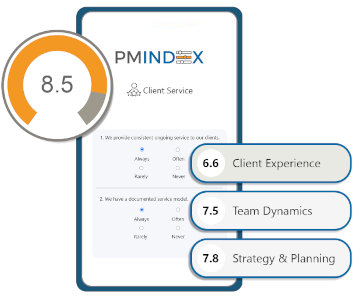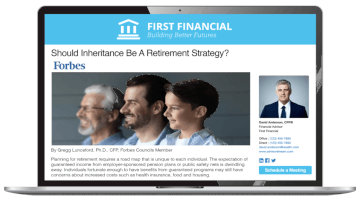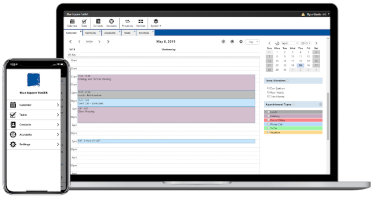2024 Financial Industry Trends Report

Gain Insights from the 2024 Financial Industry Practice Management Trends Report
When we launched the Practice Management Index in 2022, we had no idea how quickly this tool would be adopted by thousands of Financial Advisors to quickly identify exactly what they need to do to make meaningful refinements in their business. As we step into 2024, financial advisors are witnessing a transformative shift, with the spotlight on embracing AI to refine operational efficiencies and enhance client engagement strategies; it is quite a time to be alive! This year, success in the financial industry isn't just about the accumulation of years of experience or the size of one's team. It's increasingly about how effectively financial advisors run their business like a business.
Our Practice Management Trends Report for 2024 aims to dissect these evolving dynamics, spotlighting the pivotal "opportunity gaps" that we have identified from all the Financial Advisors that have completed the Practice Management Index Assessment in 2023. An opportunity gap is defined as the divergence between a practice's current state and its optimal potential.
What does it truly mean to operate at full potential? Are there untapped areas within your practice that, if addressed, could drive significant growth and improvement? This year, we delve into how financial advisors are reimagining their approach to practice management, from client interaction to internal processes, in a bid to achieve unparalleled efficiency and client satisfaction. Our report seeks to answer these questions, guiding advisors on the path to realizing their practice's full potential.
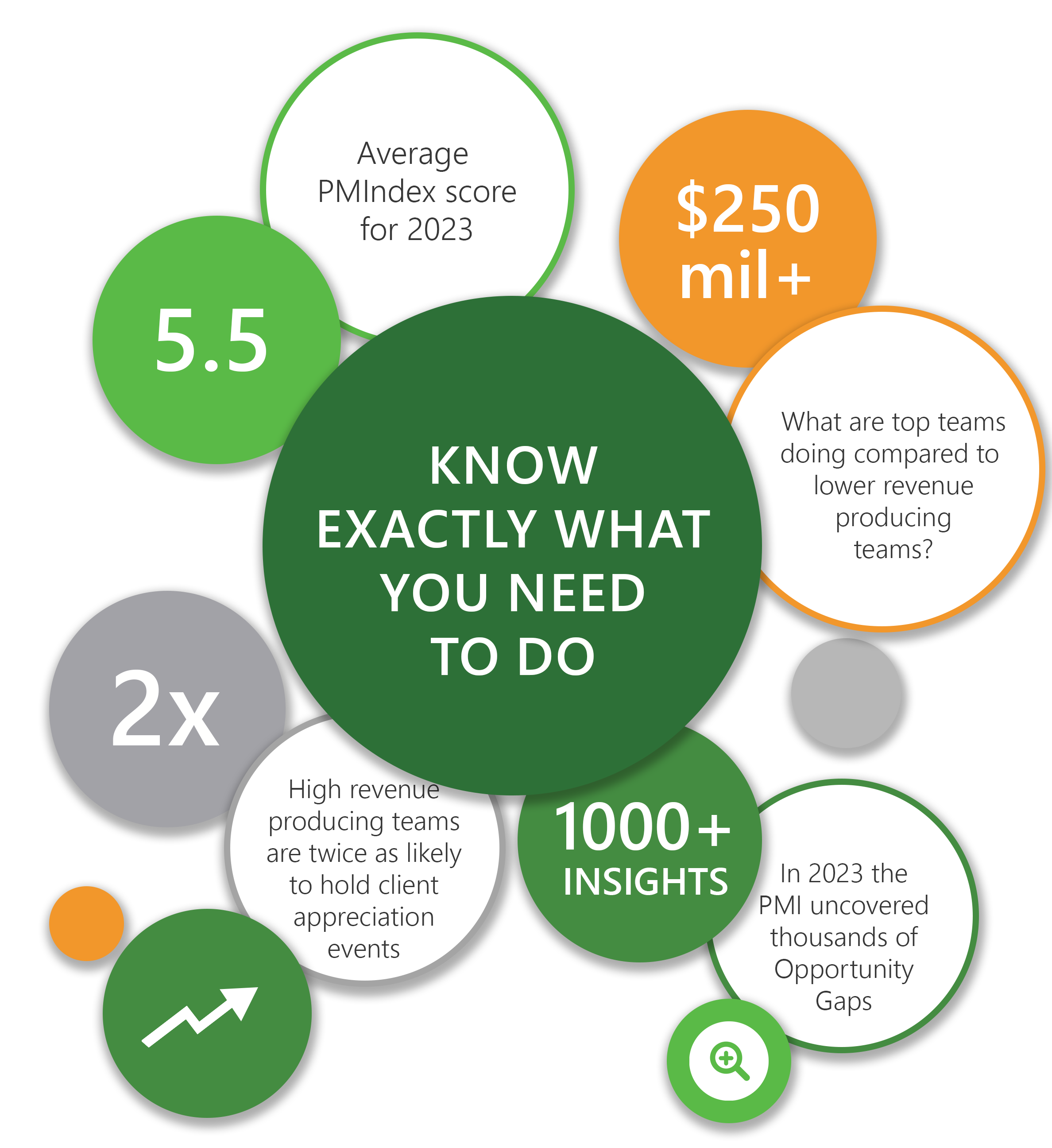
Key Contents of this Report
- Introduction
- The Practice Management Index
- Respondents Profile
- Six Foundations of a Successful Financial Advisor Practice
- Looking Deeper
- Financial Industry 2023 PMI Scores
- Where Do Financial Advisors Stand?
- Opportunity Gaps: A Tale of Two Teams
- Strategic Planning
- Systems and Process
- Branding and Communication
- Client Events
- Strategic Partners
- Client Perceptions
- Ideal Clients and Introductions
- Know Exactly What You Need to Do
The Practice Management Index (PMIndex)
The information, evaluation and insights in this report are derived from the Practice Management Index (PMIndex), which is a detailed assessment of a financial advisor's practice management capabilities. The PMIndex provides a quantitative measure for financial advisors and teams to know "where they rank" compared to their peers, with an overall PMIndex score on six integral pillars of their business and 18 focus areas in practice management.
The data is aggregated and derived from the 174+ point PMIndex assessment, and the intake form comprising demographic and socioeconomic information - including the number of financial professionals on a team, staff, clients, Assets Under Management, annual revenue, and percentage of recurring revenue. This data is used to uncover hidden patterns, unknown correlations and trends that provide useful business insights across the industry. You will find such insights in this report. In addition, this report will provide a meaningful comparison for the Financial Professionals that have completed the PMIndex, so that they can compare themselves to their peers within the industry.
Our intent is to provide Financial Professionals with a benchmark of success, so that each year they can measurably and progressively run a more productive and predictable business, become a better team, and a better version of their former selves.
You can take your PMIndex for 2024 at this link: practicemanagementindex.com

Respondents Profile
This report uses data gathered from respondents who are financial professionals within North America. Commonalities shared by respondents are that they:
- Dedicate time to improving their business through practice management, relationship
management, marketing and business development. - Often are teams that may be stuck in the status quo, and want to gain clarity on the gaps
that exist within their business. - Are individuals and businesses motivated to see new levels of growth, efficiencies, productivity and predictability in their business.
No personally identifiable information is used in this report.

Six Foundations of a Successful Financial Advisor Practice
The path towards a successful and sustainable practice is underpinned by the mastery of six foundational pillars; the bedrock for constructing a robust and flourishing business. As the year unfolds, it presents a prime opportunity for reflection, goal setting and implementation. Now is the time to harness your ambitions and resolutions, channeling them towards reimagining, refining, and rejuvenating your business.
Foundation #1) Strategic Planning
Strategic planning is much more than just making a one-time plan. It's a continuous, flexible process that shifts and grows with your business and the team you work with. It's about diving deep to find both opportunities for growth and potential risks, really understanding what the practice does well and where it can improve. You need to bridge the gap between what you plan to do and what actually gets done by setting clear, achievable goals, keeping an eye on key performance metrics, and planning for what's coming next. Essentially, strategic planning is all about being proactive, well-informed, and quick to adapt - ready to pivot on a dime - ensuring your practice isn't just "making it through" but thriving.
Foundation #2. Productivity and Efficiency
What is the secret to skyrocketing productivity? It lies not in working more hours, but in working smarter. Those that clearly assign roles & responsibilities and cleverly hand off routine tasks to others, in and outside the team, free up more time for higher-priority activities and client interactions. Advisors then have the time to really focus on what they do best" connecting with clients and strategic partners, the real MVPs in the growth and happiness of the practice.
It's like finding the perfect puzzle pieces. Advisors start zeroing in on clients whose dreams and goals align perfectly with what the practice offers, crafting relationships that are rewarding for both sides. It's about doing more of what works and less of what doesn't, making sure every move, every effort, adds a little more to the pot of profitability. By putting their energy into the most impactful activities, the practice isn't just running more smoothly; it's racing towards success with the wind at its back.
Foundation # 3) Client Service
Don't just service your clients; aim to give them an experience they'll want to rave about. Switch from being reactive to providing proactive service that makes every interaction, meeting, or call count. This is about making your interactions so valuable that your clients feel more connected to you than ever. Develop your service model to be elevated for your best clients, distinct from the competition, and a magnet for new clients.
Foundation # 4) Client Success
What could be simpler? Focus on the success of the client, rather than your success. Focus on developing a culture that is client-centered, with every thought, process, and interaction being about your clients and the experience you provide: Everything from your new client fit process, to implementing a consistent onboarding strategy, to welcoming clients into the practice. Central to this approach is identifying and working closely with ideal clients whose needs and expectations align perfectly with your expertise. Your business will be a reflection of what you put into it; your success will be a byproduct of your client's success.
Foundation # 5) Marketing and Branding
What perception do your clients have of your business? Create a brand identity that resonates with clients and sets expectations they can get excited about. Your personal and business branding and marketing strategy needs to ensure prospective and existing clients understand and appreciate everything can do for them over the lifetime of your relationship. It's not just about communicating your value in various mediums, such as your website or on social media, it's also about demonstrating your value with every interaction with clients through the people on your team, your practice and your process.
Foundation #6. Team Dynamics
Team dynamics are the heartbeat of a financial practice, with the environment and culture taking their cues from the top. Your team isn't just part of the machinery; they're the driving force. This is an environment where every team member feels charged up and in sync with the practice's objectives, where everyone belongs, where growth is on the daily agenda, where consistent communication actually happens, and innovative ideas are freely discussed. Does this sound like a team that you would like to be a part of?
Related: Important Question to Ask Yourself
Looking Deeper - Where Do Financial Advisors Excel and Where Do They Fall Short?
The following table provides aggregate scoring of Financial Advisors in 2023, within the overall ranking of the six foundations of practice management, broken down by 18 focus areas. Each is scored out of 100. The higher the score, the better the ranking:
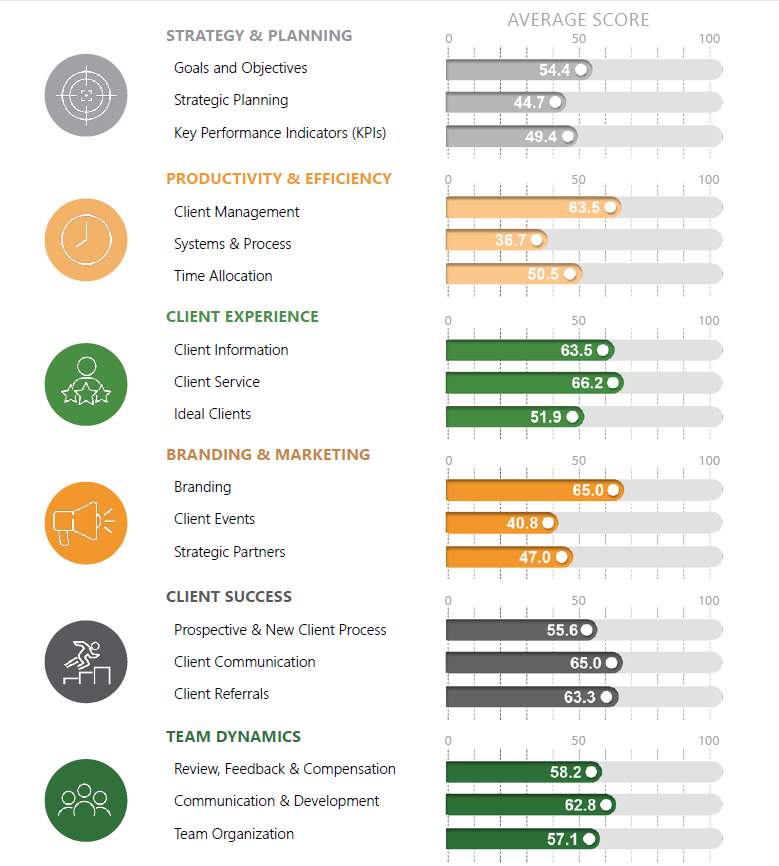
Financial Industry 2023 PMIndex Scores
The following PMIndex scores represent the overall average, high and low scores given to Financial Advisors in 2023. The maximum and best score being 10. The PMIndex score is calculated as an aggregate of all answers in the PMIndex assessment, within the context of six foundations of practice management.
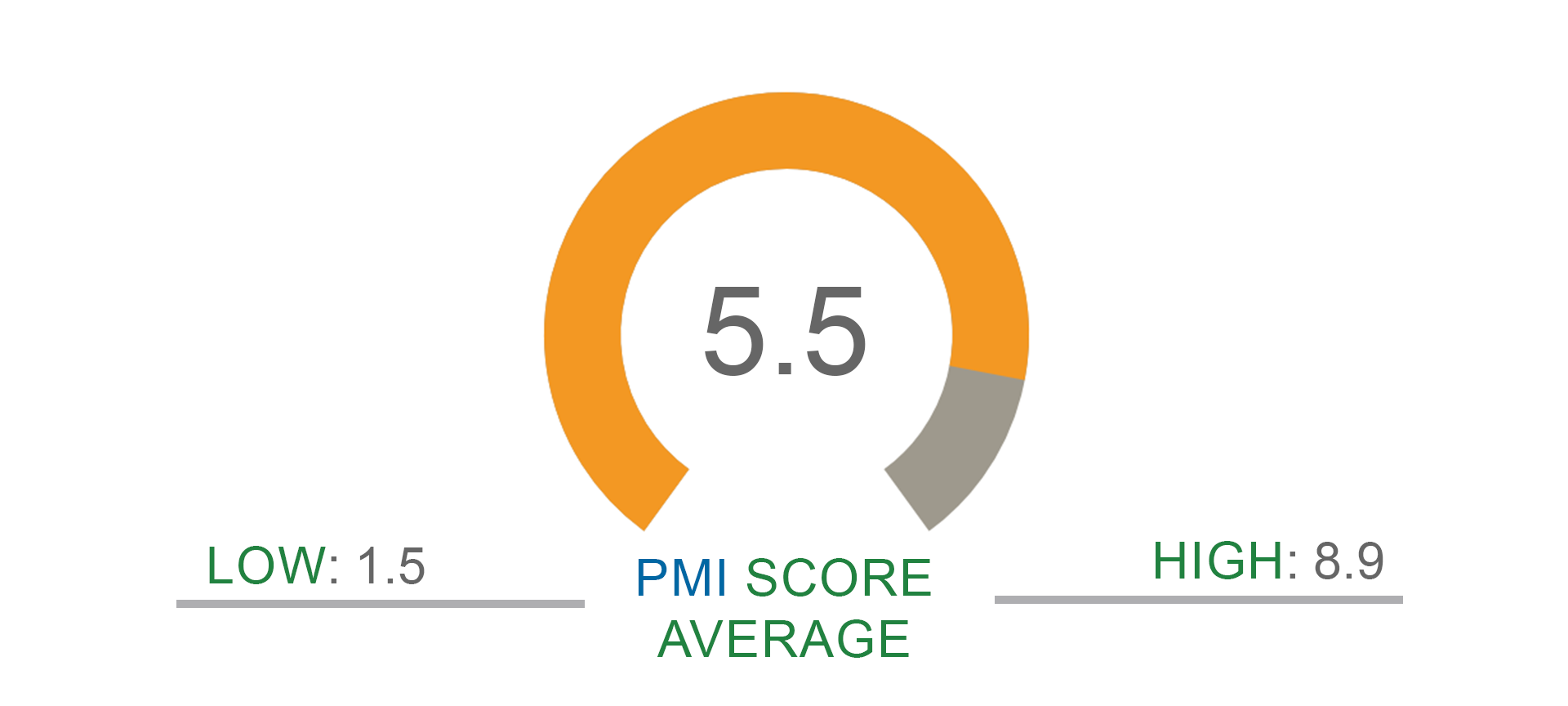
Where Do Financial Advisors Stand?
Significantly Above Average (8.5 - 10)
PMIndex Scores that fall within this range indicate the respondents scored well above their peers, and have the fewest opportunity gaps to refine in their business. They likely make prudent decisions and have a thriving business, including a productive team, excellent communication with their clients and strategic partners, and execute on well-defined systems and processes to create a very consistent client experience.
Above Average (6.2 - 8.4)
PMIndex Scores that fall within this range indicate that they scored above their peers, and have a smaller number of opportunity gaps to improve their business. They likely have a well- established business including an efficient team, consistent systems and processes to create an elevated client experience, and are looking for smaller refinements in most aspects of their business.
Within Average Range (4.6 - 6.1)
PMIndex Scores that fall within this range indicate that the professional scored within the average range of their peers, and have a reasonable number of opportunity gaps they can address to improve their business. They likely have an established business that includes some defined processes, executes fairly consistently on the client experience, but they recognize the clear path to growth and efficiently is through more defined systems and better communication with clients and strategic partners.
Below Average (3.9 - 4.5)
PMIndex Scores that fall within this range indicate that the respondents scored below their peers, and have a high number of opportunity gaps to target to improve their business. Further, they likely have an operational business, require more consistency and defined processes, are looking to significantly improve the client experience, better manage their clients and focus their time and energy more productively.
Significantly Below Average (0 - 3.8)
PMIndex Scores that fall within this range indicate that respondents scored well below their peers, and have a significantly higher number of opportunity gaps to improve in their business. They likely are in a business foundation-building phase to increase process consistency and efficiency, dramatically elevate the client experience and better demonstrate and communicate their value to clients.
Opportunity Gaps - A Tale of Two Teams
Top Financial Advisor Teams Managing $250 million or more VS Financial Advisor Teams Managing Less than $40 million. We selected the most interesting data points.
The pursuit of excellence is not just a goal but a relentless journey. This year's PMIndex report unfolds an intriguing narrative, juxtaposing high-revenue-producing teams managing assets over $250 million against their counterparts overseeing less than $40 million.
This comparison, far from being a mere statistical exercise, illuminates the nuanced strategies and practices that distinguish the leaders from the learners. For the high achievers, it's about fine-tuning the engine of their operations to achieve that additional 1% improvement across the board, turning "good" into "great."
The following pages provide a snapshot of the most significant trends and opportunity gaps for financial professionals and teams identified through the PMIndex in 2023.
Strategic Planning
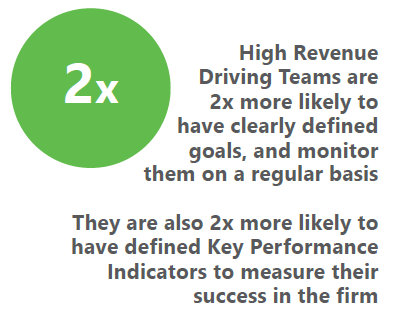
High performing financial advisor teams distinguish themselves significantly through their focus on strategic planning. This disciplined approach to goal setting is a key driver of their success, enabling a focused and aligned effort towards achieving measurable outcomes.
Additionally, these top-performing teams leverage Key Performance Indicators (KPIs) as essential tools for measuring success; providing actionable insights that help these teams evaluate their progress and make informed decisions.
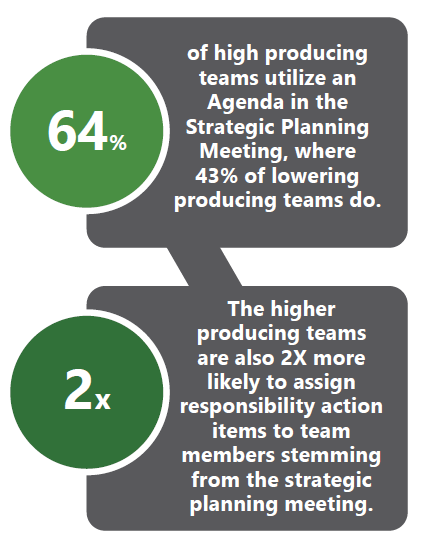
The utilization of structured agendas in strategic planning meetings and the assignment of responsibilities for action items are two practices that starkly differentiate high performing teams from lower-performing teams. This structured approach ensures that discussions are focused, time-efficient, and aligned with the team's strategic goals, facilitating a more productive planning process.
Furthermore, the assignment of responsibility for action items stemming from these strategic planning meetings is another area where high performing teams excel. Here, 64% of high performing teams make it a point to assign specific responsibilities to team members, ensuring accountability and follow-through, whereas only 32% of lower-performing teams practice this.
Systems and Process
The adoption of Customer Relationship Management (CRM) software marks a significant distinction between high performing and lower-performing teams in client management and operational efficiency. Specifically, 74% of higher performing teams utilize CRM software to manage their clients and store important information, a practice that contrasts with only 41% of lower performing teams. This technological adoption underscores the strategic advantage gained through efficient data management and the ability to track client interactions, preferences, and to create a better client experience.
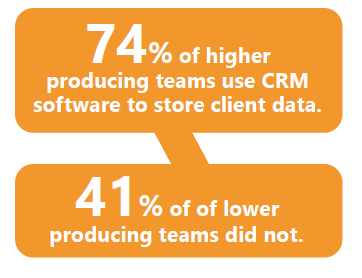
Classifying clients, integrating these classifications into CRM systems, and utilizing these classifications to prioritize and manage
client interactions are best practices that differentiate higher performing teams from lower performing ones.
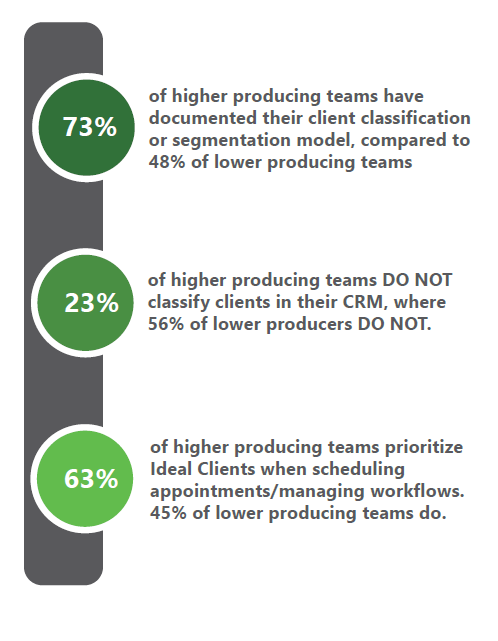
Additionally the strategic use of client classification to schedule appointments, manage workflow, and prioritize ideal clients is adopted by 63% of higher performing teams, compared to 45% of lower performing teams. This practice not only enhances operational efficiency but also ensures that resources are allocated effectively, with a focus on maximizing value for both the firm and its clients.
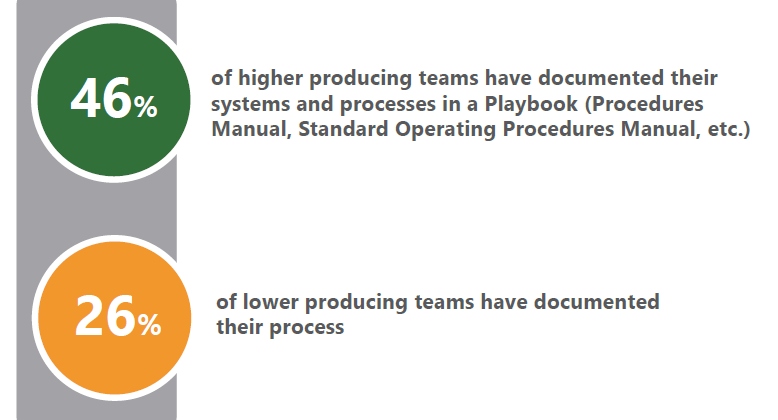
The documentation of systems and processes in a playbook, such as a Procedures Manual or Standard Operating Procedures Manual, is a critical practice that sets higher performing teams apart from their lower performing counterparts. This documentation ensures that all team members have clear guidelines and standardized procedures to follow, contributing to efficiency, consistency in service delivery, and the ability to predictably onboard new team members. It reflects a commitment to quality and operational transparency, serving as a foundation for sustained high performance and continuous improvement.
Branding and Communication
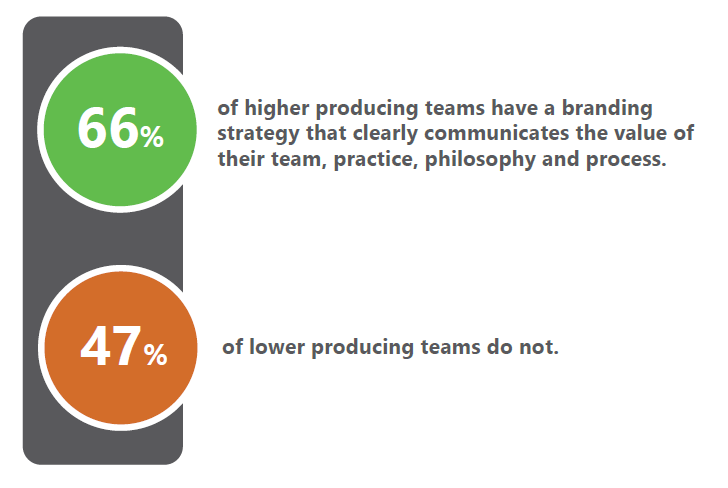
A clear and effective branding strategy that communicates the value of the team, practice, philosophy, and process is significantly more prevalent among higher performing teams. Such a strategy not only helps in conveying the unique value proposition and core beliefs of the team but also plays a crucial role in attracting and retaining clients who align with the team's philosophy and approach. The emphasis on clear communication through branding demonstrates a strategic effort to build trust and credibility.
Related video: Be Brilliant at Branding
Client Events
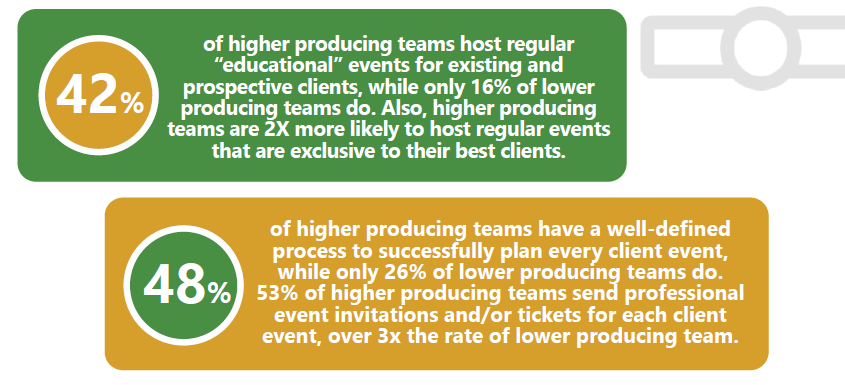
Hosting regular educational events for existing and prospective clients is a practice more common among higher performing teams, with 42% engaging in this activity compared to just 16% of lower performing teams. This approach not only serves as an effective tool for client engagement and education but also positions the team as a valuable resource beyond the immediate financial services provided.
Furthermore, the tendency to host exclusive events for the best clients is notably higher in higher performing teams, with 51% adopting this strategy versus 20% of lower performing teams. This exclusivity enhances client relationships and loyalty by making top clients feel valued and appreciated. A well-defined process for planning client events is reported by 48% of higher performing teams, compared to 26% of lower performing teams, indicating a strategic and methodical approach to event management that ensures each event meets its objectives and enhances the client experience.
Additionally, the practice of sending professional event invitations or tickets is significantly more prevalent among higher performing teams, with 53% doing so, contrasting sharply with only 15% of lower performing teams. This level of professionalism not only enhances the perceived value of the events but also reflects the team's commitment to quality and attention to detail.
Strategic Partners
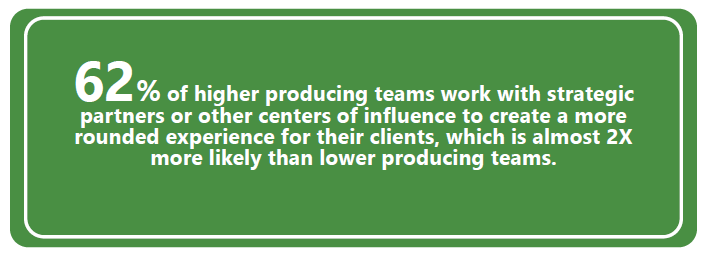
Engaging with strategic partners or centers of influence, like accountants or estate planning attorneys, to offer a more comprehensive client experience is a tactic significantly more commonly employed by higher performing financial advisor teams, with 62% participating in such collaborations, in contrast to 33% of lower performing teams. This approach shows a commitment among higher performing teams to provide holistic financial solutions that extend beyond traditional financial advice, and enables them to position themselves as their clients' "Personal CFO."
Client Perceptions
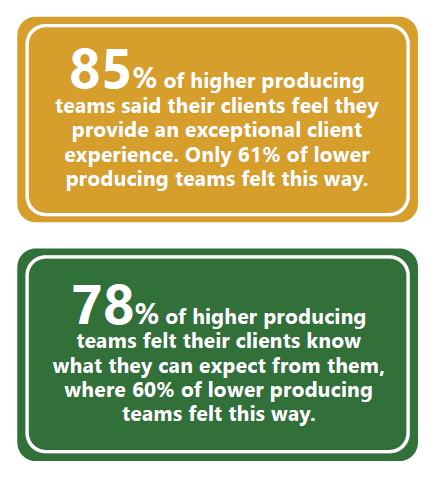
The perception of providing an exceptional client experience significantly differentiates higher performing teams from their lower-performing counterparts, with 85% of higher performing teams receiving such feedback from their clients, compared to 61% of lower performing teams. This substantial gap underscores the effectiveness of higher performing teams in delivering services and interactions that not only meet but exceed client expectations.
The clarity of client expectations stands out as a key differentiator between higher performing teams and their lower-performing counterparts. With 78% of higher performing teams reporting that their clients have a clear understanding of what to expect from them, in contrast to 60% of lower performing teams, it highlights the importance of transparent communication and setting clear expectations in building trust and satisfaction. This gap suggests that higher performing teams are more effective in communicating their value proposition, services, and the outcomes clients can anticipate.
Ideal Clients and Introductions
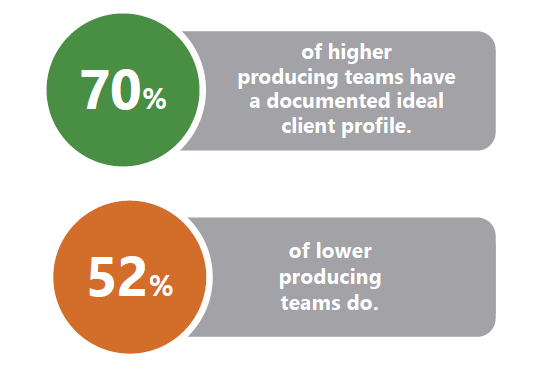
The presence of a documented ideal client profile is more common among higher performing teams, with 70% reporting they have such profiles, compared to 52% of lower performing teams. This practice highlights the strategic approach of higher performing teams in defining and understanding their target market. By having a clear, documented profile of their ideal client, these teams can more effectively tailor their marketing, service offerings, and client interactions to attract and retain clients who best fit their business model and value proposition.
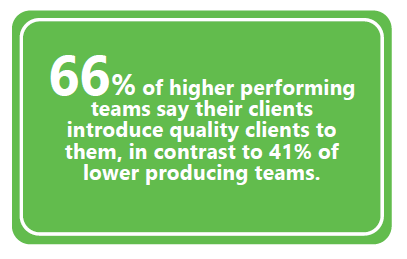
A significant distinction between higher performing financial advisor teams and their lower performing counterparts is evident in the rate at which their clients introduce quality clients.
Related Article: Secret to More Client Referrals
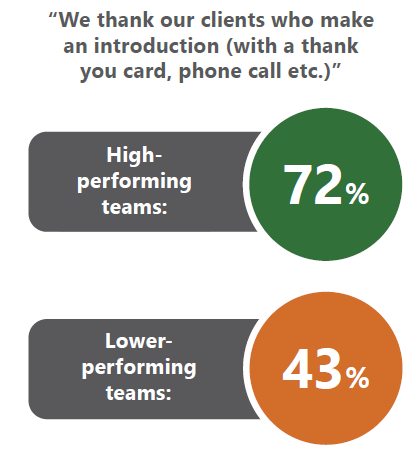
The practice of expressing gratitude toward clients who make introductions, such as through thank-you cards or phone calls, is significantly more prevalent among higher performing teams, with 72% engaging in this gesture, compared to 43% of lower performing teams. This approach underscores the importance of acknowledging and valuing the contributions clients make to the growth and success of the business. By taking the time to personally thank clients for referrals, higher performing teams strengthen their relationships, fostering a sense of appreciation and mutual respect. This practice not only enhances client loyalty but also encourages the continuation of such valuable introductions.
Know Exactly What You Need To Do
As we draw this report to a close, financial advisors face a pivotal moment - adapt and refine using 2023's insights or risk stagnation. Excellence hinges on self-improvement and leveraging technology to enhance productivity and client communication.
What is the critical move? You must develop a playbook. It's your blueprint for a consistent client experience, organic growth, and scalability amidst technological shifts. This year, the choice is stark" embrace innovation or fall behind.
Your playbook is not just a strategy, it's your ticket to leading in your field. The future is about adaptation, and your readiness to evolve determines your success.
What can you do now, to begin your journey of optimization? It starts here:
- Assess Your Opportunity Gaps - Determine specific action items that you can take to begin to reach the full potential of your business. You can take your PMIndex for 2024 at this link (45 minutes): practicemanagementindex.com
- Consider a Financial Advisor Coach or a Mentor - Find someone that can provide an outside view on your business, but also provide accountability and implementation support.
- Create A Plan - Outline what steps and action items you will implement. You can utilize the PMI reporting as the foundation for this plan.
- Action Must Be Taken - Don't just put a plan together, be accountable to it. Using coaching programs with resources, templates, worksheets, scripting, agendas and tutorials can provide the foundation for implementation.
- Constant Reassessment - Monitor your progress by completing the PMIndex annually. This will provide you with a framework for meaningful and measurable progress over time.



